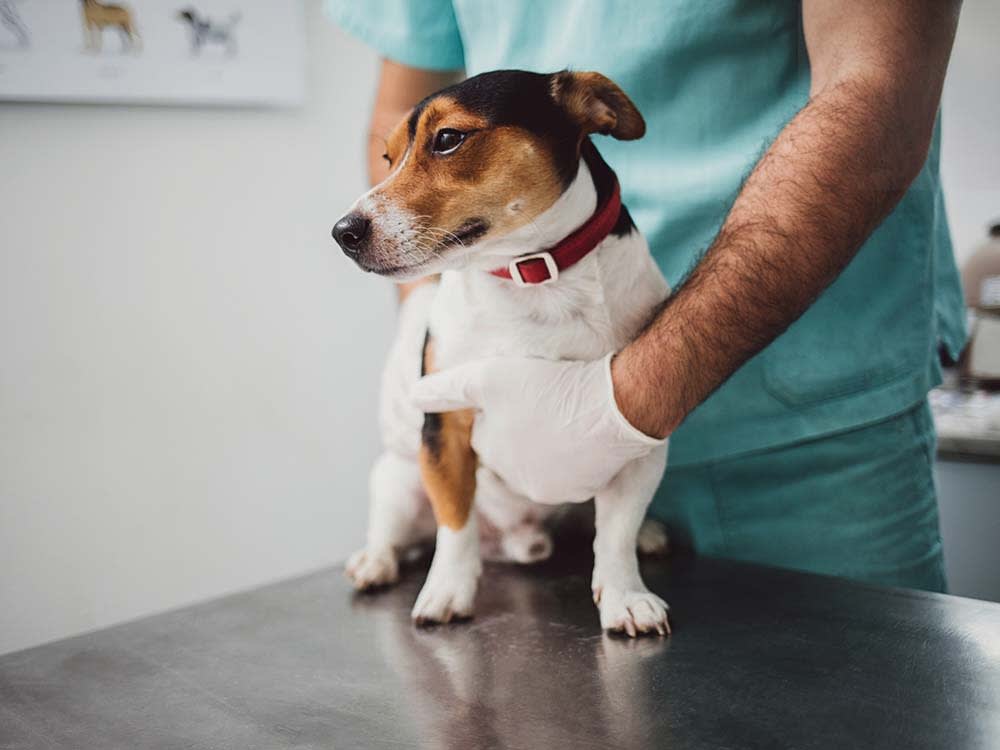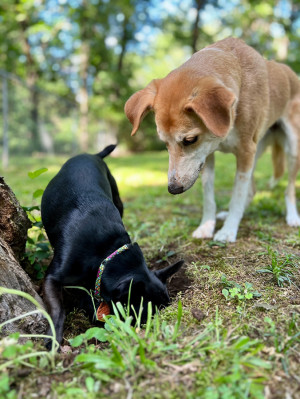HGE in Dogs: Causes, Symptoms and Treatment
Certain symptoms could mean your dog is battling a potentially fatal condition called haemorrhagic gastroenteritis (HGE). Here’s everything you need to know

share article
As a vet, one of the more common emergencies I see in dogs is a stomach condition called haemorrhagic gastroenteritis, also known as HGE. When pet parents rush their dogs in for treatment, the story I hear is always the same: “My dog started having diarrhoea and then, all of a sudden, it became very watery and bloody.” Vomitingopens in a new tab can also play a part, leaving some dogs dehydrated and fighting for their lives. This can be horrifying to first-time observers, but how does it happen and what does it mean? Let’s break that down.
What is HGE in dogs?
Haemorrhagic gastroenteritis (HGE) is a serious condition in dogs that can cause bloody diarrhoeaopens in a new tab, vomiting and dehydration. The exact cause of HGE is unknown, but it is thought to be triggered by a combination of factors, including stress, diet and infection. Dogs of all ages and breeds can be affected by HGE, but it is most common in young, small-breed dogs. If you think your dog may have HGE, it is important to seek veterinary care immediately. HGE can be a life-threatening condition, but with prompt treatment, most dogs make a full recovery within a few days.
What are the symptoms of HGE in dogs?
Haemorrhagic gastroenteritis manifests as a sudden onset of watery, bloody diarrhoea in dogs and sometimes vomiting. It’s a shedding of the intestinal lining due to severe inflammation and is often identified by ‘chunks’ of tissue in otherwise watery stool.
We describe those chunks as ‘raspberry jam’ or jam-like bloody diarrhoeaopens in a new tab. When this happens, it is extremely dehydrating for the dog – much more than you would think from the amount of diarrhoea observed – and dogs can go from near-normal to near-death in a frighteningly short amount of time.
Thankfully, when HGE is fully treated, there are usually no long-term health impacts. However, some dogs with sensitive GI tracts can have the syndrome recur in the future.
What causes HGE in dogs?
Stress, sudden dietary changes and hyperactivity seem to be predisposing factors, but the actual cause of this disease remains unknown. A bacterium called Clostridium is also thought to play a role. In reality though, it’s a bit of a medical mystery. And I understand a pet parent’s confusion and frustration when they ask, “But what actually caused it?” More than 80 percent of the time, I can’t point to an exact cause.
One thing’s for sure though. Smaller dogs seem to be more vulnerable to HGE, and it should be noted that the smaller the dog, the more dangerous the condition. Small dogs just don’t have the same bodily reserve as larger dogs; it doesn’t take much diarrhoea for them to become severely dehydrated.
How is HGE in dogs diagnosed?
There are no specific tests for HGE, but one called a packed cell volume (PCV) test is helpful in narrowing down the diagnosis. Using a few drops of blood, it measures the percentage of blood volume made up by red blood cells. A normal packed cell volume for a healthy dog is between 37–55 percent, meaning that percentage of blood volume is red blood cells and the rest is fluid and white blood cells.
When a dog becomes very dehydrated, the percentage of blood fluid drops due to less fluid in the bloodstream, usually causing the percentage of red blood cells to increase. A dog with HGE will generally have a PCV greater than 60 percent.
A PCV test also gathers a measurement of total protein (sometimes called total solids) from the blood sample, which, in HGE patients, is usually low or normal. So a very high PCV, low total protein count and acute onset bloody, watery diarrhoea all point to an HGE diagnosis.
Even with the PCV test, because diarrhoea in dogs can have so many causes, additional testing such as radiographs, a faecal exam (that includes a parvovirus test) and blood tests may be recommended to rule out other issues. HGE really becomes a diagnosis of exclusion: when all other tests are normal, we highly suspect HGE as the cause.
How is HGE treated?
The heart of therapy for HGE is very aggressive fluid replacement with intravenous fluids. The goal is to get the packed cell volume back to the normal range and keep (or get) the dog out of shock. Food is withheld for at least 12–24 hours and then gradually introduced after any vomiting has subsided. Symptomatic treatment for nausea and belly discomfort is typically included, as is antibiotic therapy, all of which is carried out within 1–3 days of hospitalisation.
With early and aggressive treatment, life-threatening complications of HGE are generally avoided and dogs happily return home.
What are the best practices for preventing HGE in dogs?
Since the cause is still unknown, it is difficult to give advice on prevention of HGE in dogs. According to the VCA Animal Hospitals, feeding your dog a high-quality, healthy diet, not giving them food they‘re not used to, and using parasite preventive medications may help prevent HGE.
How can I support my dog’s recovery after HGE?
First and foremost, follow your veterinarian‘s recommendations for helping your dog recover from HGE. They will likely include doing things like giving your dog the space and time to recuperate – make sure they have a comfortable place to rest and monitor them for symptoms such as vomiting and diarrhoea. If they return, take your dog back to the vet ASAP. Your vet may also tell you to limit your dog‘s access to food and water until their stomach fully recovers.
Frequently asked questions
Can HGE recur in dogs?
When HGE is fully treated, there are usually no long-term health impacts. However, some dogs with sensitive GI tracts can have the syndrome recur in the future.
Can you treat HGE in dogs at home?
No, it is inadvisable to treat your dog for HGE at home – it requires immediate medical attention and potential hospitalisation. Take your dog directly to the vet or animal hospital.
Can HGE be fatal?
Yes, unfortunately HGE can be fatal – it’s essential to get your dog to a vet quickly to get medical treatment.
References

Dr. Shea Cox, DVM, CVPP, CHPV
Dr. Shea Cox is the founder of BluePearl Pet Hospice and is a global leader in animal hospice and palliative care. With a focus on technology, innovation and education, her efforts are changing the end-of-life landscape in veterinary medicine.
Related articles
![Two dogs digging outside in the dirt.]() opens in a new tab
opens in a new tabTypes of Worms In Dogs: How to Detect and Treat Worms In Dogs
Here are the types of worms your pup could get, how you know they have them in the first place and how to get rid of them for good
![Dog standing in the bathtub covered with a green towel after a bath.]() opens in a new tab
opens in a new tabStep-by-Step Guide: Expressing Dog Anal Glands Safely & Effectively at Home
Yeah, it’s not exactly pleasant – but your pup will thank you
![dog near pee spot on carpet]() opens in a new tab
opens in a new tabHow to Remove Dog Wee and Other Stains from Carpet – Without Harsh Chemicals
The next time your dog wees on your favourite rug, be prepared with this simple, three-step cleaning method
![weird dog rolling in poop]() opens in a new tab
opens in a new tab7 Weird Dog Behaviours Explained
Chasing their tails, eating grass and rolling in rubbish – should you worry?
![dog hiding under christmas dinner table eating scraps]() opens in a new tab
opens in a new tabWhich Christmas Foods Can My Dog Eat?
From turkey to mince pies, Brussels sprouts to parsnips, find out which festive foods it’s safe to sneak your pup from the table
![Same sex couple with their dog lying on the bed laughing at his farts]() opens in a new tab
opens in a new tabHere’s Why Your Dog Farts So Much
Expert solutions for your pup’s flatulence







